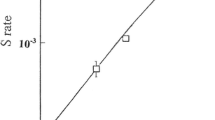Abstract
The response to possible precursors of methionine was determined in 137 methionine-requiring mutants ofSchizosaccharomyces pombe. Probably, homocysteine is directly synthesized from homoserine and sulphate. One mutant, growing on synthetic medium with vitamin B12 only, indicates a side pathway. Six complementation groups were observed in a sample of 27 homocysteine-requiring mutants.Met-3 andmet-4 were found to be allelic with a distance smaller than 0.01 recombination unit, which demonstrates that the second linkage group inS. pombe, proposed earlier, is a continuation of the linkage group presented byLeupold (1958).
Similar content being viewed by others
References
Ali A. M. M. (1966). Nitrous acid-induced mutants inSchizosaccharomyces pombe.Indian J. Genet. 26: 337–349.
Ali A. M. M. (1967). A second linkage group and the possibility of mitotic recombination inSchizosaccharomyces pombe.Can. J. Genet. Cytol. 9: 473–481.
Clowes R. C. (1958). Nutritional studies of cysteineless mutants ofSalmonella typhimurium.J. Gen. Microbiol. 18: 140–153.
Hockenhull D. J. D. (1949). The sulfur metabolism of mold fungi. The use of biochemical mutant strains ofAspergillus nidulans in elucidating the biosynthesis of cystine.Biochem. Biophys. Acta 3: 326.
Horowitz N. H. (1950). Biochemical genetics ofNeurospora.Adv. in Genetics 3: 33.
Horowitz N. H. (1955).Symposium on amino acid metabolism. Discussion, 631, Baltimore: Johns Hopkins Press.
Lampen J. O., Roepke R. R. & Jones M. J. (1947). Studies on the sulfur metabolism ofE. coli. III. Mutant strains ofE. coli unable to use sulfate for their complete sulfur requirements.Arch. Biochem. 13: 55.
Leupold U. (1958). Studies on recombination inSchizosaccharomyces pombe.Cold Spr. Harb. Symp. Quant. Biol. 23: 161–170.
Phinney B. O. (1948). Abstract inGenetics 33: 624. (Cited after Clowes, R. C. 1958).
Roberts, R. B., Abelson, P. H., Cowie, D. B., Bolton, E. T. & Britten, R. L. (1955). Studies of biosynthesis inEscherichia coli. Publ. Carneg. Inst. 607: Washington, D.C.
Shepherd C. J. (1956). Pathways of cysteine synthesis inAspergillus nidulans.J. Gen. Microbiol. 15: 29.
Simmonds S. (1948). Utilization of sulfur containing amino acids by mutant strains ofEscherichia coli.J. Biol. Chem. 174: 717.
Steinberg R. A. (1941). Sulfur and trace element nutrition ofAspergillus niger.J. Agric. Res. 63: 109.
Vogel H. J. (1955). A convenient growth medium forNeurospora.Microb. Genet. Bull. 13: 42–43.
Wiehers J. L. & Garner H. R. (1964). Use of S-methyleysteine and cystathionine by methioninelessNeurospora mutants.J. Bacteriol. 88: 1798–1804.
Author information
Authors and Affiliations
Rights and permissions
About this article
Cite this article
Ali, A.M.M. Complementation studies withinmet-3 and the location ofmet-4 inSchizosaccharomyces pombe . Genetica 41, 334–341 (1970). https://doi.org/10.1007/BF00958916
Received:
Issue Date:
DOI: https://doi.org/10.1007/BF00958916




